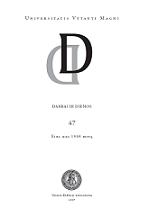Trauminiai socialinio kūno vaizdiniai „sąstingio" laikotarpio Lietuvos tapyboje
Traumatic images of the social body in Lithuanian painting of the period of "stagnation"
Author(s): Linara DovydaitytėSubject(s): History
Published by: Vytauto Didžiojo Universitetas
Keywords: Traumatic; images; social; body; Lithuania; painting; stagnation;
Summary/Abstract: The article focuses on the issue of art and politics during the years of'stagnation'. It offers analyses that indicate how the social body was represented in Lithuanian paintings of the 1970s. Painters of this period began to represent reality through specific signs of the social environment, i.e. through attributes of daily life, as it were a 'close up' of the body in society. The generation of painters that emerged in the early 1970s appropriated the principles of the expressive visual language of the 1960s; it tended to reject abstract, metaphorical representations of man and reality. Images of the body, banal objects and public space — these were the elements that became central to their painting; they often expressed problematic psycho-physiological and social-individual experiences. Artists often chose images and techniques that revealed their negative views of'post-totalitarian society' (Vaclav Havel's term) and highlighted the complex status of the subject in the Soviet system. The article analyzes the work of two young artists of the 1970s, Algimantas Kuras (b. 1940) and Arvydas Saltenis (b. 1944), as an example of social critique and the intermingling of both resistance and conformation in Soviet painting. Representations of banal objects in the paintings of the 1970s, especially those by Kuras, replaced culturally significant symbols characteristic of earlier Lithuanian art which privileged things as signs of private space. Unlike the case in post-industrial Western art, things were not perceived as objects of critique or as fetishes of the society of the 'spectacle'; in Lithuanian painting, they were both a continuation and a sign of the subject's psychic reality. Paintings that represented decrepit and discarded things, and emphasized marks of deterioration and disintegration, embodied a capacious metaphor of entropy and 'frozen' time which expressed the socio-psychological sensibilities turned into visual signs that served to establish the romantic character of an abstract image. Critique of reality in Kuras and Saltenis manifests itself through abject representations of the body in 'dirty' or shameful situations. Instances of clearly expressed opposition of the individual and the system are absent; however, psychical margins of individual reality and a communal, de-privatised aspect of Soviet life begin to emerge in the work of the two painters. Traumatic images of the private, brought into the public sphere, are followed by representations of public space seen as the site of the subjects drama. The narrative of daily life dominates in Saltenis' work; it is created by depicting specific scenes of public life in the city where the subject experiences extreme situations of alienation.
Journal: Darbai ir dienos
- Issue Year: 2007
- Issue No: 47
- Page Range: 115-138
- Page Count: 24
- Language: Lithuanian

